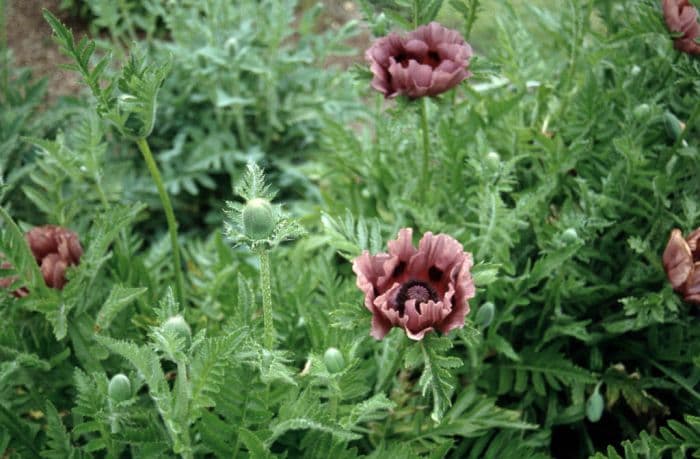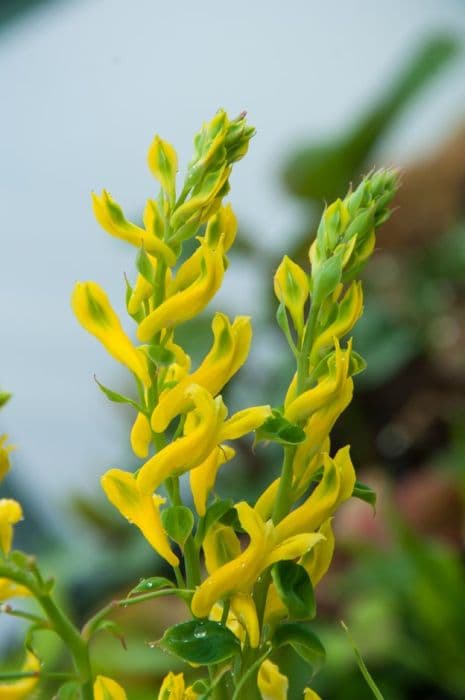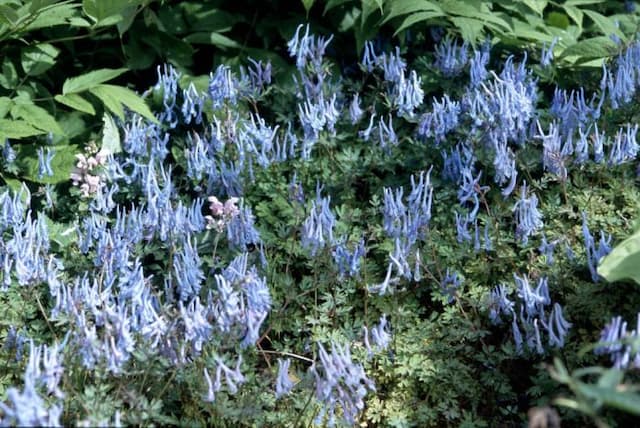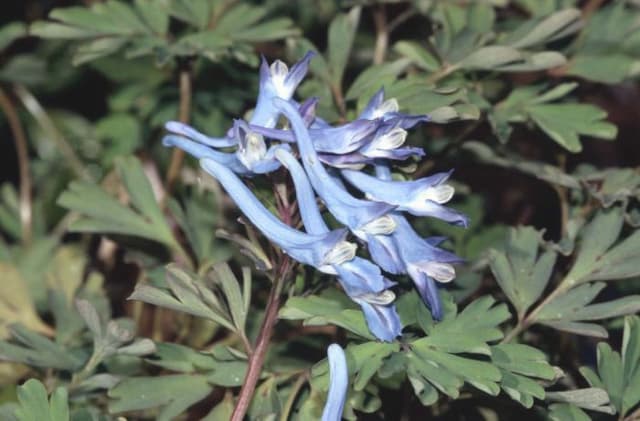Patty's Plum Poppy Papaver (Oriental Group) 'Patty's Plum'

ABOUT
The 'Patty's Plum' is a captivating plant known for its striking flowers that contribute to its popularity in gardens. It boasts lush, green foliage that provides a pleasant backdrop to its standout feature, the blooms. The leaves are deeply lobed, presenting a somewhat ruffled appearance that adds to the overall texture of the plant. The flowers of the 'Patty's Plum' are particularly noteworthy for their unique color, a rich plum shade that's both deep and luscious. These blooms have a satiny sheen and a delicate, papery quality, featuring large, cup-shaped petals that gracefully bow out from a central cluster of dark, ornamental stamens. The intriguing color of the flowers is a visual delight, often described as dusky or smoky, setting this plant apart from other varieties with more traditional hues. These captivating flowers grow atop sturdy stems which emerge from the plant's base and rise above the foliage, providing a striking vertical element to garden compositions. During its blooming period, 'Patty's Plum' transforms into a show-stopping specimen that invites viewers to take a closer look at its distinctive beauty and the subtle interplay of its floral tones. Overall, the elegance and charm of the 'Patty's Plum' flowers make this plant a coveted choice for those looking to add a touch of sophistication to their horticultural endeavors.
About this plant
 Names
NamesSynonyms
Oriental Poppy, Patty's Plum Poppy
Common names
Papaver orientale 'Patty's Plum'.
 Toxicity
ToxicityTo humans
The Oriental poppy 'Patty's Plum' is generally not considered highly toxic to humans. However, all parts of poppies can contain alkaloids that may cause mild stomach upset if ingested in large amounts. Symptoms can include nausea, vomiting, and diarrhea. While severe poisoning is unlikely, it is advisable to avoid ingesting any part of the plant.
To pets
Oriental poppies, including 'Patty's Plum', are also not considered highly toxic to pets, but they do contain alkaloids that can potentially cause mild gastrointestinal upset if ingested. Symptoms in pets might include drooling, vomiting, and diarrhea. Although serious toxicity is rare, it is best to prevent pets from ingesting any part of the plant.
 Characteristics
CharacteristicsLife cycle
Perennials
Foliage type
Deciduous
Color of leaves
Green
Flower color
Plum
Height
2-3 feet (60-90 cm)
Spread
1-2 feet (30-60 cm)
Plant type
Herb
Hardiness zones
3-7
Native area
Asia
Benefits
 General Benefits
General Benefits- Attractive Blooms: Produces unique plum-colored flowers that add a beautiful aesthetic to any garden.
- Pollinator Friendly: Attracts bees and beneficial insects that play a crucial role in pollination.
- Low Maintenance: Once established, requires little attention beyond occasional watering during dry periods.
- Drought Tolerant: Adapts well to drier conditions making it suitable for xeriscaping.
- Seasonal Interest: Adds a splash of color in the late spring to early summer when many other plants are not in peak bloom.
- Cottage Garden Appeal: Fits in perfectly with traditional cottage garden designs.
- Deer Resistant: Less attractive to deer, which can help prevent damage to the garden.
- Easy to Propagate: Can be easily propagated from seed, allowing gardeners to create more plants economically.
 Medical Properties
Medical PropertiesThis plant is not used for medical purposes.
 Air-purifying Qualities
Air-purifying QualitiesThis plant is not specifically known for air purifying qualities.
 Other Uses
Other Uses- As a natural dye: The petals of the Oriental poppy can be used to create a subtle dye for fabrics, paper, or in artistic creations.
- Photography subject: With its unique color, 'Patty's Plum' is an excellent subject for botanical photography and art, inspiring artists and photographers with its beauty.
- Educational tool: This plant can be used in school gardens or educational programs to demonstrate plant life cycles and pollination, as bees are often attracted to its blooms.
- Garden design: 'Patty's Plum' can be used in garden design to provide a contrast against green foliage or complement other flowers with similar hues.
- Floral arrangements: While not long-lasting as cut flowers, fresh blooms can be used in floral arrangements for quick events such as weddings or parties.
- Companion planting: This variety can be planted alongside vegetables to attract pollinators to the garden, potentially increasing the yield of vegetable crops.
- Cultural symbol: In certain cultures, poppies may serve as a symbol in ceremonies or festivities, representing aspects like sleep and peace.
- Dried floral crafts: The seed pods of 'Patty's Plum' add an interesting texture and shape to dried flower arrangements and crafts.
- Seed harvest: The seeds of the Oriental poppy can be collected and used for replanting or for sharing with fellow garden enthusiasts.
- Thematic gardens: The plant can be included in war memorial gardens, as poppies are a symbol of remembrance in many countries.
Interesting Facts
 Feng Shui
Feng ShuiThe Oriental poppy is not used in Feng Shui practice.
 Zodiac Sign Compitability
Zodiac Sign CompitabilityThe Oriental poppy is not used in astrology practice.
 Plant Symbolism
Plant Symbolism- Rest - Poppies in general are symbolic of rest and recovery due to their ability to induce sleep through their opiate content.
- Peace - The poppy's association with sleep also extends to its representation of peace and a respite from the world.
- Remembrance - Especially with red poppies, they serve as a symbol of remembrance of soldiers who have died during wartime.
- Beauty and Success - The 'Patty’s Plum' variety, with its unique and attractive plum color, can represent beauty, success, and luxury.
- Consolation - Poppies can be a symbol of comfort and consolation possibly due to its sedative effects, giving solace to those in grief.
 Water
WaterOriental Poppies, including 'Patty's Plum', should be watered deeply but infrequently to encourage deep root growth. Water approximately once a week, providing about 1 inch of water each time, which is roughly equivalent to 0.6 gallons per square foot. Adjust the frequency to account for rainfall; during prolonged dry spells, you may need to water twice a week, while during cooler and wetter periods, you can water less often. It's critical to ensure the soil around 'Patty's Plum' dries out between waterings, as they do not tolerate soggy conditions well. Overwatering can lead to root rot, so it's better to err on the side of too little rather than too much.
 Light
Light'Patty's Plum' Oriental Poppy thrives best in full sun, where it can receive at least 6 to 8 hours of direct sunlight daily. Choose a spot in the garden that is unobstructed by tall trees or buildings to ensure it gets ample light. They can tolerate partial shade, but flowering may be reduced, and the stems may become leggy as they reach for the light.
 Temperature
TemperatureOriental Poppies like 'Patty's Plum' prefer temperatures that range between 50°F and 75°F but can tolerate temperatures as low as 20°F and as high as 90°F. Their ideal growing conditions involve cool nights and warm days. They go dormant in extreme summer heat, especially when temperatures consistently rise above 90°F.
 Pruning
PruningPrune 'Patty's Plum' Oriental Poppy after it has finished flowering, typically in late spring or early summer, to promote healthy growth and prevent self-seeding if not desired. Cut back the foliage to the ground level, as Oriental Poppies are herbaceous perennials that will regrow from their roots. Pruning annually will help maintain a tidy plant appearance and encourage vigorous growth for the following season.
 Cleaning
CleaningAs needed
 Soil
SoilThe Oriental Poppy 'Patty's Plum' thrives in well-drained soil enriched with organic matter. A soil mix of equal parts loam, peat moss, and perlite or sand would promote healthy growth. Aim for a slightly acidic to neutral pH between 6.5 and 7.
 Repotting
RepottingOriental Poppies, including 'Patty's Plum', are perennials that do not require frequent repotting. Most are grown from seed or transplanted as seedlings and should not be repotted as they prefer not to be moved once established.
 Humidity & Misting
Humidity & MistingThe Oriental Poppy 'Patty's Plum' prefers a garden environment and doesn't require high humidity. It can do well in average outdoor humidity levels, with no need for specific humidity control.
 Suitable locations
Suitable locationsIndoor
Place in a sunny spot and ensure good air flow for the Oriental Poppy.
Outdoor
Grow in full sun with well-draining soil for the Oriental Poppy.
Hardiness zone
3-7 USDA
 Life cycle
Life cycleThe Oriental Poppy 'Patty's Plum' begins its lifecycle with seed germination, occurring in late winter to early spring, where seeds sprout and develop into small rosettes. As temperatures rise, the rosettes form a strong taproot and foliage begins to grow vigorously. Flowering occurs in late spring to early summer, with 'Patty's Plum' producing distinctive plum-colored blooms that attract pollinators for reproductive success. After blooming, the petals fall and the plant sets seed in the form of a capsule, which eventually dries and releases seeds for the next generation. Post-flowering, the foliage of 'Patty's Plum' dies back to the ground, and the plant enters a period of dormancy during the hot summer months. In the autumn, new foliage appears again, and the plant continues to gather energy in preparation for the next season's growth and flowering.
 Propogation
PropogationPropogation time
Spring to Summer
The Oriental Poppy 'Patty's Plum' is typically propagated by division, which is best done in late summer or after the plant has finished blooming. To propagate by division, carefully lift the plant from the soil, ensuring that you keep as much of the root system intact as possible. Then, using a sharp spade or knife, divide the clump into smaller sections, making sure that each section has a piece of the root and at least one growth point or eye. After the division, replant the sections at the same depth they were originally growing, spacing them about 12 inches (approximately 30 centimeters) apart to give each new plant enough space to grow. Water the new plants thoroughly after planting to help them establish. This form of vegetative propagation ensures that the new plants will be exact replicas of the 'Patty's Plum' variety, retaining all its desirable characteristics.









